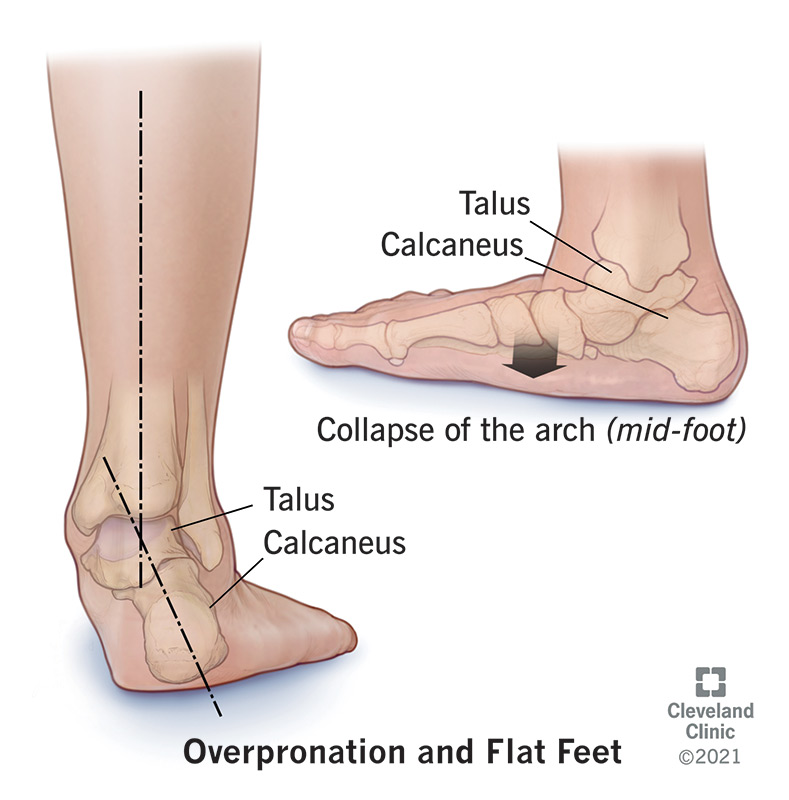Overpronation happens when your gait (the way you walk or run) eventually causes the arches of your feet to flatten more than they would normally. Overpronation increases the risk you’ll injure your foot and leg. But you can correct the problem with exercise and by adding orthotic insoles to your shoes.
Advertisement
Cleveland Clinic is a non-profit academic medical center. Advertising on our site helps support our mission. We do not endorse non-Cleveland Clinic products or services. Policy

Overpronation happens when your gait (the way you walk or run) eventually causes the arches of your feet to flatten more than they would normally. That puts strain on muscles, tendons and ligaments that support your arches. Overpronation increases the risk you’ll injure your foot and leg. But you can correct the problem with exercise and by adding orthotic insoles to your shoes.
Advertisement
Cleveland Clinic is a non-profit academic medical center. Advertising on our site helps support our mission. We do not endorse non-Cleveland Clinic products or services. Policy
People who have slightly flattened feet are more likely to develop overpronation. Other conditions or activities are:
Overpronation refers to your gait, or the way you walk, which can cause flat feet. Flat feet (flat foot) is a medical condition when you have little to no arch in your foot. Flat feet can be hereditary or develop over time.
In some cases, people have flat feet (flat foot) because they never developed arches in their feet. In other cases, your arches suddenly fall or collapse after injuring the leg tendon that supports your arches. This condition is fallen arches or adult-acquired flat foot.
Both terms describe the way you pronate, or walk. Overpronation and underpronation happen when your foot lands on your heels’ outer edges. Ideally, your feet transfer the landing impact to the balls of your feet. In overpronation, your feet shift the impact too far. In underpronation, also known as supination, your feet don’t shift the impact far enough. With overpronation, your foot rolls inward when you walk. With underpronation, your foot rolls outward when you walk.
Overpronation can cause your feet to flatten. Most people who develop overpronation often start with slightly flattened feet. If you already have flat feet, you’re more inclined to develop overpronation.
Advertisement
The soles of your shoes might provide the first clue you have overpronation. If the inside section of your shoes’ soles show more wear than the outside section, you might have overpronation.
Other signs are conditions you might develop because you have overpronation. Overpronation is linked to several conditions and symptoms, such as:
Your healthcare provider will start by checking your arches, including how well your arches function when you put weight on them. They may evaluate your gait or the way you walk, too.
Treatment for overpronation usually includes:
Most people who have overpronation can manage symptoms by making a few changes to their routines:
You can prevent overpronation by wearing shoes that fit well and support your arches. If you’re still concerned, ask your healthcare provider for a formal diagnosis.
There are several ways to take care of yourself:
You should see your healthcare provider any time you have persistent foot, ankle or leg pain that doesn’t go away after rest.
If you don’t have flat feet, overpronation increases the chance you’ll develop flat feet. If do you have flat feet, overpronation can cause serious injuries that require treatment and time to heal. If you think you might have flat feet, talk to your healthcare provider. They’ll diagnose your condition and recommend ways to help you keep your feet in good shape so you can stay up to speed with your daily activities.
Advertisement
From sudden injuries to chronic conditions, Cleveland Clinic’s orthopaedic providers can guide you through testing, treatment and beyond.

Last reviewed on 03/01/2022.
Learn more about the Health Library and our editorial process.